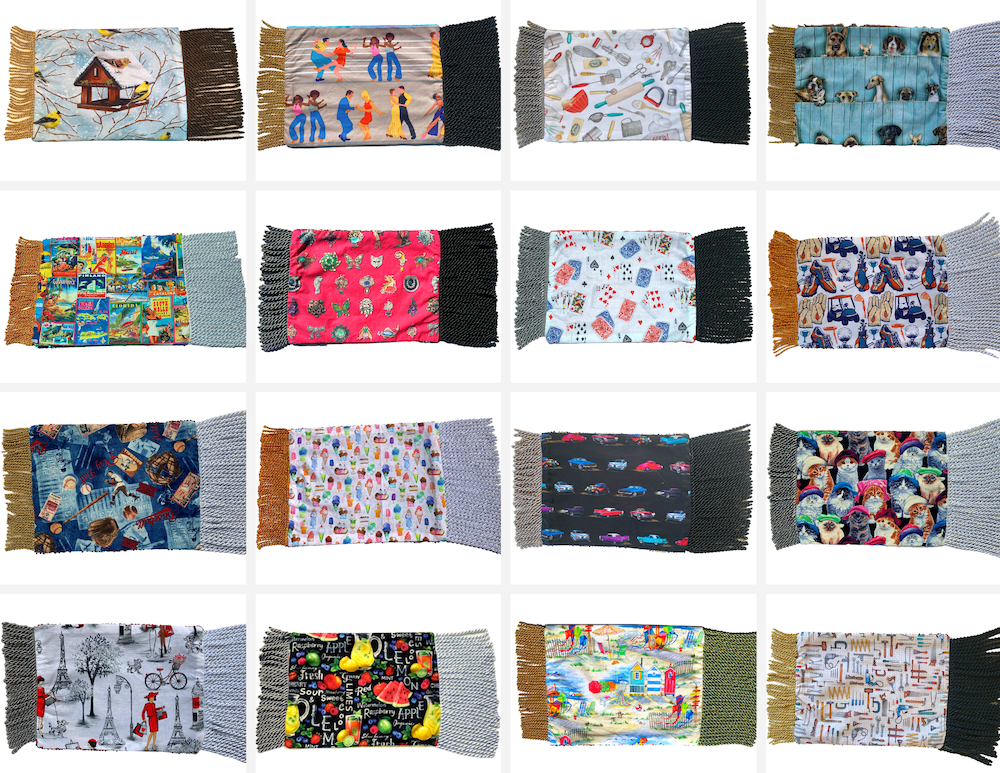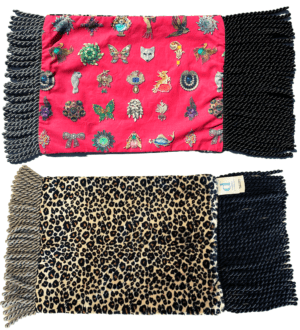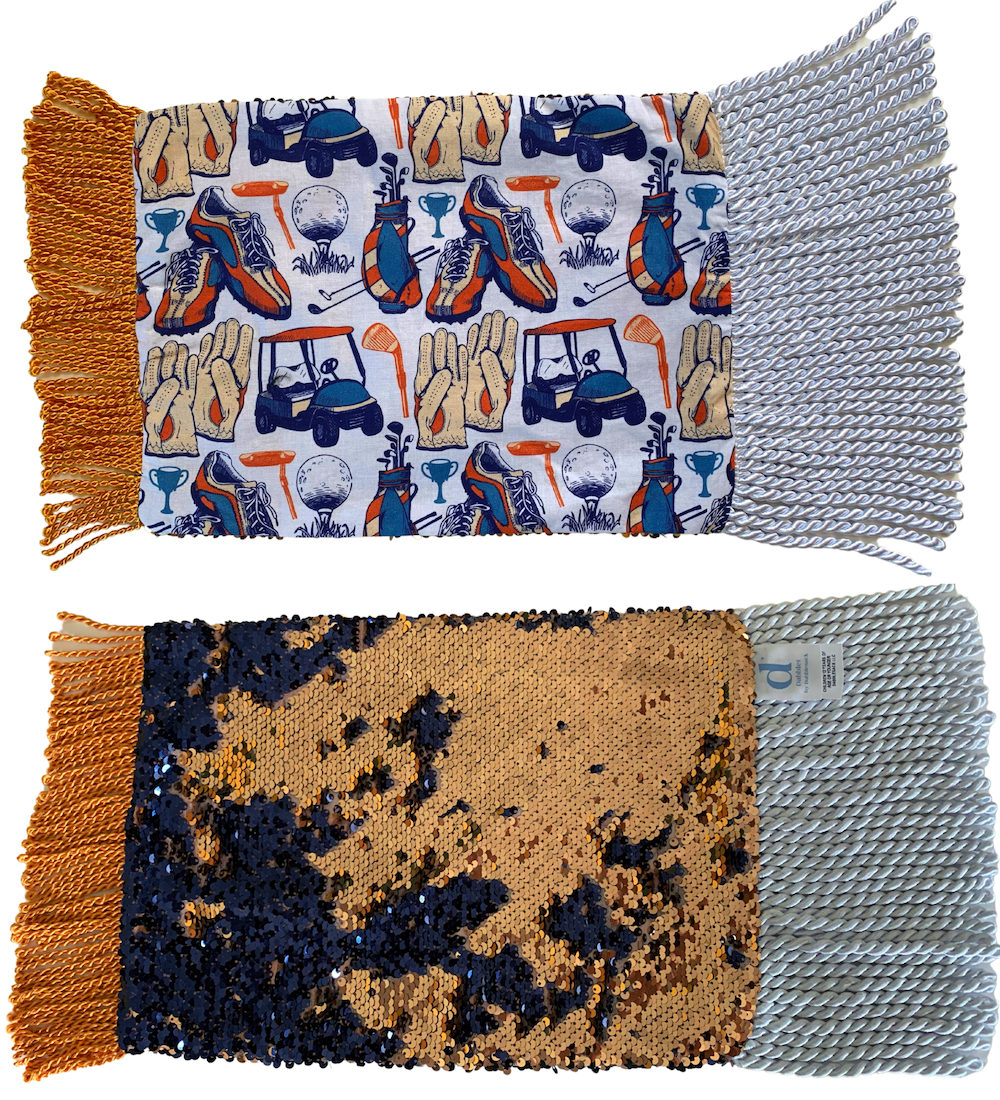Dementia Challenges, Strategies, and an Introduction to Dabblets (Videos)
 Submitted by Robyn Martin OTR/L and Rebecca Strichman OTR/L
Submitted by Robyn Martin OTR/L and Rebecca Strichman OTR/L
Co-Founders
Dabblesack
As two occupational therapists, we created fabric fidget soothers called “Dabblets” to help address some of the challenges that can come with dementia. Learn more about them below.
Throughout the years, during home care visits, we’ve often heard family members of someone living with dementia comment:
- “Mom gets so frustrated or anxious sometimes.”
- “Dad gets very few visitors, so he sits alone a lot.”
- “Why does Mom get so fidgety and pick at her clothes or wring her hands?”
- “How can we keep Dad more focused or involved?”
- “What can we do to make things a little better?”
These questions are important because the more we recognize and understand the challenges that come with dementia, the more empowered we feel to manage them.
This article will begin by focusing on two dementia challenges as well as some strategies to help address them. We will then discuss Dabblets as an additional strategy to help soothe, comfort, and provide an opportunity for conversation and reminiscing.
Frustration, Anxiety, and the Need to Fidget
People living with dementia can feel frustrated and anxious, and this may result in a tendency to fidget. This can occur during any stage of dementia but is most common in the middle to later stages.
There can be many causes of frustration or anxiety for those living with dementia. Some of those causes include:
- A general sense of having lost the ability to correctly navigate through the home environment (for example, from the bedroom to the bathroom or kitchen)
- The inability to fully express feelings and needs like feeling tired or hungry, the need to use a bathroom (or having an incontinence product replaced), or experiencing pain or discomfort
- A sense of loss due to difficulty managing or processing daily activities
- A lack of stimulation and resulting boredom leading to a sense of “what am I supposed to be doing?”
- Difficulty processing the world properly, which can result in feedback from others such as, “You know who I am, we’ve been friends for forty years.” (This well-intentioned comment can serve to enhance the overall loss of having a handle on things and can compound the feelings of frustration and anxiety.)
Strategies to Address Frustration, Anxiety, and the Need to Fidget
For family members, friends, and caregivers of people living with dementia, it is helpful to have strategies to manage that individual’s frustration, anxiety, and the need to fidget. Try to keep the causes of frustration and anxiety to a minimum.
Point out “landmarks” in the home to help with orientation: “I always know I’m in your bedroom when I see that colorful quilt” or “There’s that beautiful picture of the beach outside your bathroom.” This may help keep someone more connected to and comfortable navigating through their environment even when doing so with assistance.
Try to become familiar with signs for the need to use the bathroom or to have an incontinence product changed.
Be aware of facial or physical signs of pain or discomfort.
Offer food or drinks throughout the day to help reduce feelings of hunger or thirst (which the individual may not always be able to express.)
Try to maintain some kind of routine when possible.
Keep the home environment and tabletops as clutter-free as possible, and make sure the room lighting is adequate.
While visitors are highly welcomed, too much of a noisy crowd may be overwhelming and can cause a sense of anxiousness.
Encourage safe participation in Activities of Daily Living when possible, including bathing, dressing, grooming, toileting, feeding, appropriate housekeeping tasks, and leisure activities.
Consider having a home safety assessment by a therapist to determine the need for safety equipment. Not only is this important for general safety but also for self-confidence as well.
For example, stepping in and out of the tub may require a grab bar and/or a seat, and if the individual does not feel steady or safe, this may feed into a sense of a lack of confidence performing this task, which can lead to a feeling of anxiousness.
Try to encourage helping out with some household chores like setting some of the table ( like putting out napkins) or folding small laundry items. This can allow someone to feel they are participating in and contributing to needs within the home, which in turn can minimize the sense of loss and frustration.
Consider going for walks or performing permitted exercise, clapping along to music, thumbing through magazines, painting or drawing, working on a puzzle, helping to sort or choose photos which can then go into albums, participating in community service projects from home, or playing a game.
Give choices when possible for a sense of autonomy (and a decrease in feeling that all independence is lost.) Avoid offering too many options however (generally no more than two) as this can create confusion and anxiousness.
Work together as a team while performing self care or leisure activities. The more someone feels “I’ve got this,” the less frustrated and anxious they might feel.
Avoid using phrases like, “Mom, you know this is your granddaughter Liz!” or “Dad, your mother is not coming here for lunch today. She would be 120 years old by now.”
Finally, when the need to fidget is apparent, provide an appropriate source for fidgeting to minimize pulling on clothes, skin etc. (We created Dabblets for this purpose, as discussed in more detail below.)
What Can I Do if the Activities of Daily Living Suggestions are too Difficult or Not Working?
For some people, modifications with verbal, demonstrated, or hands-on cues may be helpful:
- Instead of asking someone to fold several items of laundry, try one small washcloth.
- If a 12-piece puzzle is too much, then just take out two pieces at a time (that you know fit together) and place them down close to each other with the fit properly aligned. Demonstrate and state how these fit together, and use your hands over the individual’s hands to gently piece the puzzle together. You can also look for puzzles with fewer pieces.
- If clapping along to music is too difficult, try simply listening to music.
- If painting or drawing is not possible, find some pictures of beautiful paintings or scenes to look at.
- If going outdoors is not an option, when possible set up a bird feeder outside the window to watch the birds and squirrels enjoy a snack. For apartment dwellers, point out the scenes outside the window including the weather, cars/trucks/buses, etc.
- Don’t worry about the rules of the game or staying within the lines of a coloring book.
Anxiety, frustration, and the need to fidget can be mitigated when people are engaged in their day in a way that allows them to feel comfortable and content.
Socialization and Conversation
People living with dementia can experience a decline in socialization and conversation which can lead to a sense of isolation, sadness, and boredom. This can be the result of many reasons, including:
- Having fewer visitors at home or fewer invitations to join others outside the home.
- In some situations, others may be present in the home but may tend to “talk over” someone with dementia instead of addressing them directly.
- At times, an individual with dementia may be alone in a room while a family member or caregiver may need to wash a load of laundry, prepare a meal, or take a shower, etc.
- Friends, family, or caregivers may not know how to work on an activity together or how to initiate or hold a conversation, especially if the individual with dementia is not always
responding, so they may avoid interaction altogether.
Strategies to Help Reduce Feelings of Isolation
There are strategies that can be incorporated into the day to help keep people stay socialized and connected with others.
When possible, invite a visitor over. If younger family members are visiting, try an intergenerational puzzle (comes with different size pieces within the same puzzle) or a themed coloring book that may spark further conversation. Activities can help make visits from grandchildren more enjoyable.
Don’t forget friends or family who can visit with a gentle pet.
Look for a local Memory Cafe to attend. You can find your nearest Memory Cafe at Memory Cafe Directory. Visit local museums (some might offer dementia-friendly programs.) When possible, find safe outings that may be enjoyable (park, restaurant, etc.)
Eat meals together if this is feasible and enjoyable. (It can sometimes be nice to add quiet background music during a meal.)
Try some activities together,. When possible, you might bake, cook, or prepare a salad (with appropriate assistance or supervision), adding some music if this is helpful or enjoyable. You can use watercolors, markers, or colored pencils to create a still life such as a bowl of fruit in the home.
When even three minutes to do any of the above is basically impossible to find (and we know that can be a reality), see if you can invite a friend, neighbor, or other family member to help. Take advantage of people who have offered, “let me know if you need anything.”
Avoid “talking over” someone or speaking about them in the third person. Allow them to be part of the conversation even if it is simply by their physical presence while others are conversing.
If you have to run a load of laundry or get dressed, consider keeping a radio or TV on, or give the individual something to hold to provide comfort. When possible, try to include him or her in what you are doing.
For example, if you are preparing lunch, have them stay in the kitchen with you (and help when possible.)
When playing a game or working together on a puzzle or craft, sit down next to each other (don’t hover over someone.) Work as a team to reduce stress.
Focus on something that can be a springboard to conversation. Talk about the picture on a puzzle or in a coloring book. Avoid statements or questions that are too lengthy or complex. If an individual is not able to respond to an open-ended question, try simple yes-or-no questions.
Try statements like: “I love your red sweater. That’s my favorite color.” or “This is such a pretty song on the radio.”
If you are not getting a response, it’s OK. Keep your voice and mannerisms relaxed or upbeat (even when you’re not feeling that way) as your mood and behavior can be sensed and reflected. Music and singing can be a very helpful socialization tool!
How many activities should I try to include each day and for how long?
We have found that there is no specific answer for this, even for the same individual. We suggest doing whatever works on a given moment or day.
Let the individual guide you in terms of how many leisure activities he or she would like to do on a given day. Some people may just be comfortable with one activity while others may prefer more.
If no interest is shown in participating in an activity (even with some gentle encouragement or trying an activity as a team), then try again later. Keep in mind that an activity that was successful at 11:00 AM on Monday may not go smoothly on Monday afternoon or at 11:00 AM on Tuesday.
As the saying goes, “try, try again” as interest can fluctuate from moment to moment, and the next attempt may be very different.
In terms of how much time should be spent on each activity, take your cues from the individual. Look for signs of fatigue, disinterest, or frustration. Put the activity away and try again another time. The next attempt may be very different in a more positive way. Even a few minutes can be enjoyable and worthwhile.
People often enjoy doing activities connected to something they always loved to do. However, they also may enjoy a new activity or even one they didn’t like doing in the past.
For example, a person who never liked doing jigsaw puzzles might now really enjoy one. This also may fluctuate from moment to moment.
Don’t feel as if you have to do non-stop activities every day. Some downtime is important too.
How Dabblets Address These Challenges
What is a Dabblet?

A Dabblet is a fabric fidget soother with a conversational component to encourage chatting, reminiscing, socialization, and engagement.
Dabblets offer a tactile experience that can help soothe and comfort, and provide a gentle source for fidgeting. Dabblets also offer a visual element to provide a springboard for conversation and socialization.
Each Dabblet comes with a card that contains 10 conversation prompts and a few suggested complimentary activities.
Who designed Dabblets and what is their purpose?
As two occupational therapists, we designed Dabblets to address certain needs that can stem from Alzheimer’s and other forms of dementia, including the need to fidget, the need to feel soothed and comforted, and the need for socialization.
Dabblets can also provide a source for gentle visual stimulation and focus.
What does a Dabblet look like?

Each Dabblet measures approximately 9 3⁄4” x 12 1⁄2”.
The front of the Dabblet has a colorful fabric with a themed printed pattern (appropriate for adults) meant to encourage reminiscing and conversation.
The back of the Dabblet comes in one of two styles. One version is a soft fabric called “Minky” which has a plush, soothing feel.
The other option is a “flip sequin” fabric. As you glide your hand from side to side across the sequins, you see them flip from one color to another. This offers a more visually engaging, but still relaxing, tactile experience.
Two different lengths of fringe on either end of the Dabblet offer an additional opportunity to fidget.
Dabblets are hand-sewn in the USA.

How are Dabblets Used?
Dabblets can be used independently for comfort or fidgeting. They can also be used with a family member, friend or caregiver as a source for conversation.
Dabblets can be used on a tabletop, draped over a lap, or the arm of a chair or wheelchair. They can be folded or rolled-up and taken to events, outings, and appointments where some extra comfort or distraction would be helpful.
How Do I Use the Prompt Card?
You can use the ten questions or statements on the prompt card that comes with the Dabblet to spark reminiscing and conversation. If the person with dementia is not able to participate in the conversation, the caregiver or family member can ask and then answer the question.
This may help the individual feel a sense of socialization or community. For example, if the prompt question is: “Do you like dogs?” and the individual is unable to reply, you can say, “I love dogs.”
Some prompts may also need to be modified. For example, if a question is open-ended, such as: “What is your favorite breed of dog?” and the individual is unable to answer, try changing it to a yes-or-no question, such as “Do you like Poodles?”
Prompt cards also come with a few suggested activities that relate to the theme of the fabric. For example, the Dabblet with the fruit pattern has suggested activities that include working together to make a fruit salad or fruit smoothie, baking a fruit pie, or drawing a picture of a bowl of fruit.
If the individual is unable to participate, keep in mind that sometimes just observing the activity can be engaging for them.
Conclusion
We hope we’ve given you some helpful pointers in recognizing and addressing some of the challenges that dementia can pose. And while you are busy caring for someone else, please remember to find ways to take care of yourself.
 Robyn Martin OTR/L
Robyn Martin OTR/L
Rebecca Strichman OTR/L
Co-Founders
Dabblesack
Robyn Martin and Rebecca Strichman are occupational therapists with 65-plus combined years of experience.
They co-founded dabblesack.com to provide a resource of curated leisure activities for seniors and people living with Alzheimer’s and other forms of dementia.
By offering engaging games, arts and crafts, soothers, puzzles, and more, along with suggestions on how to modify these activities as needed, Rebecca and Robyn hope to empower care partners to include activities into a plan of care for wellness.


